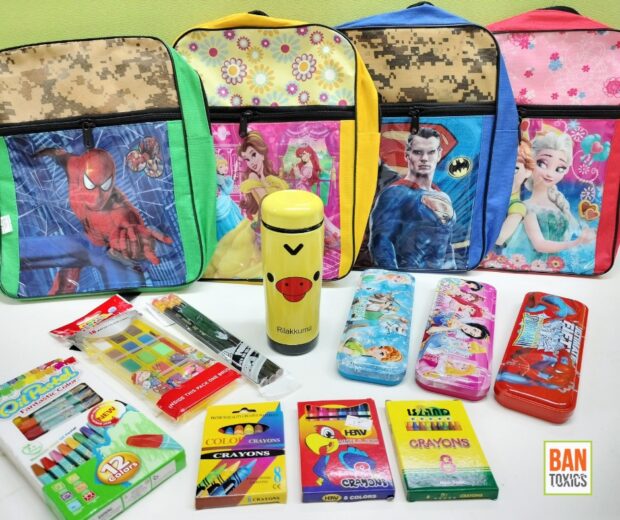
Parents warned against Toxic Lead in School Supplies! Toxic watchdog group BAN Toxics urged parents to be prudent and practice caution in buying school supplies after its recent market surveillance of school supplies in a popular public market tested positive for toxic lead a cumulative toxicant that affects multiple body systems and is particularly harmful to young children.
PHOTO FROM BAN TOXICS FACEBOOK PAGE
MANILA, Philippines — With the opening of classes on Aug. 29, BAN Toxics, a watchdog group monitoring toxic products, warned parents on Saturday to be careful in buying school supplies after market surveillance showed that several school items being sold in Divisoria, Manila, had tested positive for lead.
The group said it had conducted a “test purchase” of school supplies such as kiddie backpacks, crayons, pastel colors, pencils, pencil cases, and water containers.
An inspection of the items using an X-ray fluorescence analyzer showed that they had lead content, with kiddie water containers having the highest concentration of 24,500 parts per million (ppm).
The group noted further that most of the sample school supplies had either incomplete or no product information.
“Our investigation proves the continued presence of toxic chemicals in children’s products. We advise parents to take necessary precautions when buying school supplies,” said Thony Dizon, toxics campaigner of BAN Toxics.
Advisories
Citing the World Health Organization, the group said lead is a toxic substance that could have a harmful impact on children as they are more exposed to it than adults.
“Lead can affect children’s brain development, resulting in reduced intelligence quotient (IQ), behavioral changes such as reduced attention span, increased antisocial behavior, and reduced educational attainment,” BAN Toxics said.
It noted further that lead could also cause anemia, hypertension, renal impairment, immunotoxicity, and toxicity to the reproductive organs.
The Department of Environment and Natural Resources had earlier issued Administrative Order No. 2013-24, which prohibits the use of lead and lead compounds in the manufacture of school supplies.
BAN Toxics also cited a public advisory by the Food and Drug Administration (FDA) in 2016 cautioning against the purchase of those items.
FDA urged consumers to always read product labels and take note of details about their manufacturer, distributor and importer.
‘Public awareness’
“Be aware of the warning or hazard symbols that may appear on the packaging, as well as instructions to follow in case of emergencies regarding the misuse of said product,” the agency said.
Consumers were also advised to buy school supplies from reputable retailers or outlets to ensure the quality and safety of their purchases.
Dizon urged the government, including local authorities, to establish consumer action centers in public markets and malls which could offer on-site assistance on product standards and safety.
“We will continue to raise public awareness on toxic chemicals in children’s products as part of our campaign for Toxics-Free and Waste-Free Schools. The protection of our children from toxic harm is their basic right,” BAN Toxics said.
Chemicals, additives
Environmental group EcoWaste Coalition also urged manufacturers to ensure product safety, emphasizing the vulnerability of young children to harmful chemicals.
“While most school supplies are safe, some might contain concerning chemicals like cadmium, lead and phthalates,” the group said.
It shared tips on buying safer school supplies by avoiding products with polyvinyl chloride–a type of plastic, often marked with “3” or “PVC,” which contains lead and other additives.
Buyers are also advised to choose erasers that are labeled “phthalate-free” and to avoid food-shaped or scented options.
EcoWaste Coalition said plain metal paper clips are better than colored ones which might contain PVC coating.
Art supplies with heavy metals should also be avoided, like lead-containing crayons as well as notebooks with PVC covers or plastic components.
In choosing water bottles, stainless steel containers are preferred, including those certified with “lead-safe” paint, if painted.